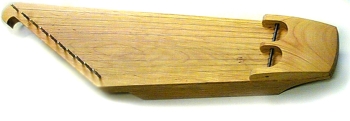|
The kantele is a traditional Finnish plucked string instrument with five metal strings in its basic form. The instrument is
bridgeless, so the strings are terminated at one end by metal tuning pins, screwed directly into the soundboard.
At the opposite end all strings are wound once around
a horizontal metal bar called the varras and then knotted. Due to this special type of termination, the strings experience a strong beating effect.
Also, nonlinearities, caused by tension modulation, have a strong effect on the sound.
The following table lists our kantele-related research in inverse chronological order. For some publications, the PDF-file and a companion web-page containing sound
examples are provided. These can be found in the leftmost column.
| Publication | Short description |
| N/A |
J. Pakarinen, V. Välimäki, and M. Karjalainen,
''Physics-Based Methods for Modeling Nonlinear Vibrating Strings.''
In Acta Acustica united with Acustica, No. 2, March/April, 2005. |
Two algorithms for simulating tension modulated strings (e.g. kantele strings) are presented: a spatially distributed
waveguide model and a finite difference model. The waveguide model is essentially the same as below, whereas the finite
difference model uses time-domain interpolation for modulating the wave velocities. Stability issues for both models
are discussed. |
 |
J. Pakarinen, M. Karjalainen, and V. Välimäki.
''Modeling and real-time synthesis of the kantele using distributed tension modulation.''
In Proc. Stockholm Music Acoustics Conference, volume 1, pages 409-412, Stockholm, Sweden, August 6-9, 2003. |
Nonlinear kantele strings are modeled using a waveguide string with spatially distributed fractional delay filters.
When the delay time of the fractional delay filters is varied, tension modulation nonlinearity can be simulated. |

 |
C. Erkut, M. Karjalainen, P. Huang, and V. Välimäki,
"Acoustical Analysis and Model-Based Sound Synthesis of the Kantele,"
J. Acoust. Soc. Am.,
vol. 112, no. 4, Oct., 2002, pp. 1681-1691. © Acoustical Society
of America, 2002. Reprinted by permission.
|
Two
peculiar features of the kantele tones,
i.e., the beating and nonlinear behavior
of the harmonics, have been described by
analysis, measurements, and synthesis. The
effect of the tension modulation driving
force (TMDF) is highlighted, and its
analytical approximation is derived. TMDF
is incorporated into the nonlinear string
model in a physically sound
fashion. |


|
V. Välimäki,
M. Karjalainen,
T. Tolonen, and
C. Erkut,
"Nonlinear Modeling and Synthesis of the Kantele - a Traditional Finnish String Instrument,"
Proceedings of the International Computer Music Conference
(ICMC'99),
Beijing, China, Oct. 22-28, 1999, pp. 220-223.
|
A
two-polarizational waveguide model with
different delay line lengths is used to
simulate the beating phenomenon. The pitch
glide effect is modeled by inserting
signal-dependent fractional delay filters
at the termination of each delay line. |
|
N/A |
Välimäki, V.,
Huopaniemi, J.,
Karjalainen, M., and
Jánosy, Z., ''Physical Modeling of Plucked String Instruments with Application to Real-Time Sound Synthesis,''
Journal of the Audio Engineering Society, vol. 44, no. 5, pp. 331-353, May 1996.
|
Various analysis and
synthesis aspects of several plucked
string instruments are discussed. A general
physics-based string model for synthesis
purposes is proposed. Time-varying
fractional delay filters are suggested for
modeling the time-varying pitch.
|
|
N/A |
Karjalainen, M.,
Backman, J., and
Pölkki, J.,
''Analysis, Modeling, and Real-Time Sound Synthesis of the Kantele, a Traditional Finnish String Instrument,'' in Proceedings of the IEEE International Conference on Acoustics, Speech and Signal Processing (ICASSP'93), vol. 2, pp. 229-232, Minneapolis, Minnesota, USA, April 27-30, 1993.
|
This first
scientific work on Kantele synthesis uses
a four-delay line waveguide model in
simulating the beating effect. The effect
of the mode coupling caused by the tension
modulation nonlinearity is implemented by
integrating the squared delay line
contents and summing the result into the
output via an experimental filter.
|
| 
|





